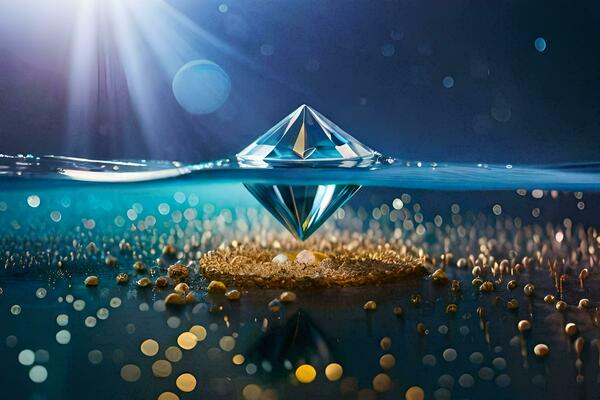Table of Contents
Understanding Diamond Cut
The term “what does diamond cut mean” often causes confusion, as many people mistakenly associate it with the diamond’s shape. However, the cut refers to how well the diamond has been shaped and faceted by a skilled jeweler to maximize its brilliance and sparkle. It’s one of the most crucial factors that contribute to the beauty of a diamond. In fact, it plays a larger role in how dazzling a diamond appears than its color or clarity.
What is Diamond Cut?
Diamond cut refers to the angles, proportions, and symmetry of a diamond’s facets, which are the flat surfaces that reflect light. A well-cut diamond will display optimal brilliance, fire, and scintillation (the sparkling effect seen when light bounces off a diamond’s facets).
While the shape of a diamond (round, oval, square) defines its overall form, the cut dictates how the diamond’s shape will interact with light, affecting its visual appeal. The better the cut, the more radiant and eye-catching the diamond will appear.
Why is Diamond Cut Important?
The cut of a diamond is vital because it directly impacts the diamond’s ability to reflect and refract light. A poorly cut diamond can appear dull, even if the diamond has high clarity and color ratings. On the other hand, a well-cut diamond maximizes its brilliance, creating an eye-catching sparkle. It’s the cut that truly makes a diamond come to life!
How Diamond Cut Affects the Sparkle
The sparkle and fire you see in a diamond are caused by light entering and bouncing off the diamond’s facets. When the facets are cut correctly, light enters the diamond and bounces around inside, reflecting out through the top of the diamond. A poor cut, however, can cause the light to leak out from the sides or bottom of the diamond, resulting in a dull appearance.
The 4 Cs of Diamonds: The Cut’s Role
Diamonds are graded based on four primary factors known as the “4 Cs”: Carat, Cut, Clarity, and Color. While all of these factors contribute to a diamond’s quality and value, the cut is often considered the most important.
Carat, Cut, Clarity, and Color
- Carat refers to the size of the diamond.
- Cut refers to how well the diamond is crafted to maximize its brilliance.
- Clarity assesses the presence of any internal or external imperfections (inclusions and blemishes).
- Color measures how colorless or yellow the diamond is.
Among these four factors, cut has the greatest influence on a diamond’s overall appearance. Even a diamond with excellent color and clarity can look dull if the cut is poor.
Where Does Cut Fit Into the 4 Cs?
Cut plays a pivotal role because it affects how light interacts with the diamond, making it sparkle. While color and clarity are important, the cut enhances the overall visual appeal, so a poorly cut diamond, even if perfect in other aspects, may still fail to capture the eye.
Different Types of Diamond Cuts
There are several different cuts available for diamonds, each offering distinct features and visual effects. Some cuts are more traditional, while others are designed for contemporary tastes. Let’s explore some of the most popular diamond cuts:
Round Brilliant Cut
The round brilliant cut is the most popular and timeless cut for diamonds. It features 58 facets (including the crown and pavilion), which are carefully designed to maximize light reflection. The round brilliant cut is known for its exceptional brilliance and is the go-to choice for many diamond buyers.
Princess Cut
The princess cut is a square or rectangular shape with pointed corners. It’s the second most popular cut, known for its modern appearance and brilliant sparkle. The princess cut is often favored for engagement rings, as it combines the elegance of a square shape with the brilliance of a round diamond.
Cushion Cut
The cushion cut combines a square or rectangular shape with rounded corners, creating a softer, more vintage look. It has larger facets that emphasize the diamond’s clarity and color. This cut is often chosen for its romantic and antique feel.
Emerald Cut
The emerald cut is a rectangular shape with cut corners and a stepped pavilion. It emphasizes clarity over brilliance, as the long, open facets highlight the diamond’s color and clarity. Emerald cuts are ideal for those who prefer a more understated and elegant look.
Asscher Cut
The Asscher cut is similar to the emerald cut but features more dramatic step cuts and a square shape. Known for its vintage appeal, it provides a timeless, art-deco-inspired aesthetic.
Oval Cut
The oval cut is an elongated version of the round brilliant cut. It offers the same brilliance but with an elongated shape, making it a great choice for those who want a larger diamond without paying for a larger carat weight. The oval cut also makes the finger appear longer and more slender.
Marquise Cut
The marquise cut has an elongated shape with pointed ends. This cut maximizes the diamond’s carat weight, making it appear larger than a round diamond of the same carat size. Its distinctive shape makes it a popular choice for unique engagement ring designs.
How Diamond Cut Affects the Price
A diamond’s cut has a significant impact on its price. A well-cut diamond will often be more expensive than a poorly cut one of the same carat weight. This is because a well-cut diamond will exhibit exceptional sparkle and brilliance, making it more desirable.
Why the Cut Influences Diamond Pricing
The cut is directly related to the overall appearance of the diamond. A diamond that is well-cut will reflect light more efficiently, making it appear more vibrant and visually stunning. This heightened aesthetic appeal increases its value.
How Cut Quality Impacts Value
The quality of the cut can affect the price by several thousand dollars. A diamond with an excellent cut grade will cost significantly more than one with a fair or poor cut, even if the other factors (color, clarity, carat) are similar.
The Diamond Cut Grading System
Lab created diamonds are graded on a scale from “Excellent” to “Poor” based on their cut quality. The grading is determined by the diamond’s proportions, symmetry, and polish.
Excellent, Very Good, Good, Fair, and Poor Cuts
Diamonds with an “Excellent” or “Very Good” cut grade will display the most brilliance, while those with a “Fair” or “Poor” grade may appear dull and lackluster.
What to Look for in a Diamond Cut Grade
When purchasing a diamond, it’s essential to look for a cut grade that enhances the diamond’s appearance. Most people opt for “Excellent” or “Very Good” cuts, which provide the best balance of beauty and value.
Choosing the Right Diamond Cut for You
Selecting the right diamond cut involves more than just considering the shape. You should think about the overall style and look you want for your diamond, as well as your budget.
How to Pick a Cut That Matches Your Style
Your choice of diamond cut should reflect your personal style. Do you prefer a timeless, classic look? A round brilliant cut might be perfect. Are you looking for something more modern or unique? Consider a princess or oval cut.
Consider the Diamond Shape and Your Ring Setting
When choosing a cut, it’s important to consider how the diamond will look with your ring setting. Certain cuts, like the marquise or cushion, look stunning in vintage-inspired settings, while round brilliant cuts pair beautifully with solitaire settings.
Cut vs. Shape: What’s the Difference?
While the terms “cut” and “shape” are often used interchangeably, they refer to different aspects of a diamond.
Clarifying the Cut and Shape Distinction
- Cut refers to the craftsmanship of the diamond—the way the facets are designed to enhance light performance.
- Shape refers to the overall outline or form of the diamond, such as round, oval, or square.
Diamond Cut and Its Impact on Light Performance
The way a diamond is cut affects its ability to reflect light, which is what gives it its sparkle.
How a Diamond’s Cut Affects Its Brilliance
A properly cut diamond will reflect light from every angle, creating maximum brilliance. A poorly cut diamond will not capture and reflect light as efficiently, leading to a duller appearance.
Light Reflection and Dispersion
The cut of a diamond affects how light enters the stone, bounces off the facets, and exits the top. This interplay creates the “fire” or color dispersion you see in diamonds.
Diamond Cut and Its Effect on Durability
While diamond cuts are mainly about aesthetics, they also affect the diamond’s durability. Certain cuts, like the princess cut, can have sharp edges that may be prone to chipping, while others, like the round brilliant, are more durable.
The Relationship Between Cut and Diamond Toughness
A diamond’s cut affects its durability. For example, round brilliant cuts are generally the most durable, while more angular cuts may have edges more prone to chipping.
How Poor Cuts Can Affect Longevity
A poorly cut diamond may be more susceptible to damage over time, so it’s essential to choose a cut that provides both aesthetic appeal and long-term durability.
The History of Diamond Cutting
Diamond cutting has a rich history, evolving from rudimentary techniques to the precision and sophistication we see today.
How Diamond Cutting Has Evolved Over Time
Diamond cutting techniques have improved drastically over the centuries, with the development of tools and technology that allow for more precise cuts and enhanced brilliance.
The Role of Technology in Modern Diamond Cutting
Advances in laser technology have revolutionized diamond cutting, allowing for more intricate and precise cuts that were once unimaginable.
Conclusion: Why Diamond Cut Matters So Much
When it comes to selecting a diamond, the cut is arguably the most important factor to consider. It has the greatest impact on the diamond’s appearance, brilliance, and overall value. Whether you prefer a classic round brilliant or a unique cushion cut, understanding the significance of diamond cut will help you make an informed and satisfying purchase.

